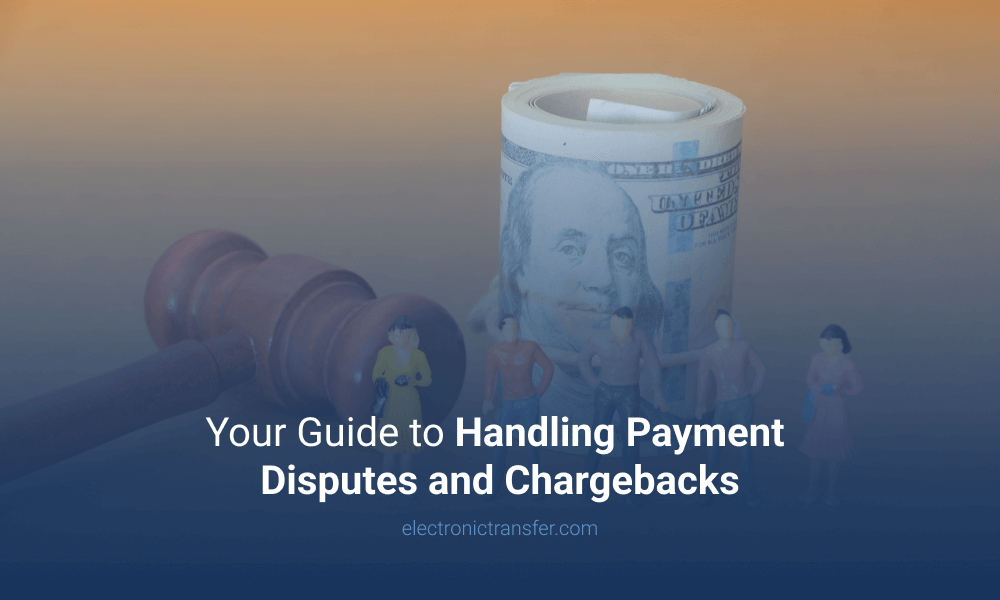Your Guide to Handling Payment Disputes and Chargebacks

Navigating disputes and chargebacks is crucial for businesses, especially those in high risk industries. This article explains the transaction lifecycle, chargeback process, unique challenges faced by high risk businesses and how specialized processors like Electronic Transfer. Inc can help protect your business and revenue. Keep on reading.
Transaction Lifecycle
Understanding how transactions work is the key to handling disputes effectively as it helps you spot and resolve any potential issues early. Let’s break down the process:
- Authorization: When a customer makes a purchase, their card information is sent to the merchant’s bank. This bank then forwards the request to the card network (like Visa or Mastercard), which passes it to the customer’s bank for approval.
- Authentication: The customer’s bank checks if the account has sufficient funds and if the transaction seems legitimate. They then send an approval or denial back through the same chain.
- Clearing: If approved, the seller submits the transaction details to their bank. This information is then sent to the card network.
- Settlement: The card network calculates what each bank owes and is owed, then facilitates the transfer of the funds.
Throughout this process, various messages are exchanged:
- Authorization requests and responses.
- Clearing records with transaction details.
- Settlement messages confirming fund transfers.
These messages are crucial in dispute resolution. They provide a trail of the transaction, helping to verify its validity or identify errors. When a chargeback occurs, these messages are often reviewed to determine the legitimacy of the dispute.

Disputes and Chargebacks
Disputes and chargebacks are mechanisms designed to protect consumers from fraudulent or improper charges. A dispute occurs when a cardholder questions a transaction on their statement. If the dispute can’t be resolved directly with the business owner, it may escalate to a chargeback.
What Is a Chargeback?
A chargeback is the formal process of reversing a transaction, where the issuing bank forcibly withdraws funds from the merchant’s account and returns them to the cardholder. This process was originally created to build consumer confidence in credit card usage, but it can pose significant challenges for sellers.
There are five main types of chargebacks:
- Chargeback fraud: The most common type, where a cardholder claims they didn’t authorize the transaction. This could be due to an actual incident or “friendly fraud” where a legitimate customer falsely claims it.
- Authorization Issues: These occur when a merchant processes a transaction without proper authorization, such as after a card’s expiration date.
- Processing errors: These include duplicate charges, incorrect transaction amounts, or charges for canceled recurring transactions.
- Consumer disputes: The category involves issues with the goods or services provided, such as items not received, defective products, or services not as described.
- Point-of-Interaction error: This category covers problems at the point of sale, like currency conversion issues or non-receipt of cash from an ATM.
Chargeback Requirements
Each card network (Visa, Mastercard, American Express, Discover) has its own set of rules governing chargebacks. These rules specify:
- Time limits for filing chargebacks.
- Required documentation for each chargeback reason code.
- Vendor rights and responsibilities in the chargeback process.
It’s vital that business owners familiarize themselves with these rules to effectively manage and dispute chargebacks.
Chargeback Process
The chargeback process is a multi-step procedure that protects consumers from fraudulent or disputed transactions while allowing merchants the opportunity to defend legitimate sales.
1. Cardholder Dispute Initiation
- The cardholder contacts their issuing bank to dispute a transaction.
- Reasons can include unauthorized charges, goods not received, or quality issues.
- The cardholder typically has 60-120 days from the transaction date to initiate a dispute, depending on the card network’s rules.
2. Issuing Bank Review
- The bank examines the dispute details and supporting evidence provided by the cardholder.
- They check if the dispute meets the criteria for a chargeback under the relevant reason code.
- If valid, they assign a reason code and proceed with the chargeback.
3. Chargeback Initiation
- The issuing bank debits the transaction amount from the acquiring bank.
- This amount, plus any applicable chargeback fees, is deducted from the merchant’s account.
- The acquiring bank notifies the seller of the chargeback, usually through their payment processor.
4. Merchant Notification and Response
- The business owner receives details of the chargeback, including reason code and deadline for response.
- They can choose to accept the chargeback or contest it through representment.
- If contesting, the vendor must gather compelling evidence to refute the reason for the chargeback.
5. Representment
- The merchant submits their rebuttal and supporting evidence to the acquiring bank.
- Evidence might include signed receipts, delivery confirmations, or correspondence with the customer.
- The acquiring bank forwards this information to the issuing bank.
6. Issuing Bank Review and Decision
- The issuing bank evaluates the merchant’s evidence against the cardholder’s claim.
- They decide to either uphold the chargeback or reverse it in favor of the seller.
- If reversed, the funds are re-credited to the account that was used for the original transaction.
7. Pre-arbitration and Arbitration
- If either party disagrees with the decision, they can escalate to pre-arbitration.
- Pre-arbitration allows for submission of new evidence or clarification of existing information.
- If still unresolved, the case moves to arbitration with the card network.
Credit Card Chargebacks in High Risk Businesses
High risk businesses are those that operate in industries or niches prone to higher rates of chargebacks, fraud, or financial instability. These can include online gambling, adult entertainment, subscription services, travel agencies, and certain types of e-commerce. For these businesses, understanding and managing chargebacks is crucial. if they want their company to manage their finances successfully, grow and become successful.
Why Do High Risk Businesses Face More Chargebacks?
High risk businesses are particularly vulnerable to chargebacks due to:
- Nature of products/services: Many high risk industries deal with intangible goods or services, which are more prone to disputes.
- Higher fraud rates: Some sectors attract more fraudulent activity, leading to increased chargebacks.
- Buyer’s remorse: Impulse purchases in certain industries can often lead to instant customer regret and subsequent chargebacks.
- Subscription model issues: Recurring billing can lead to disputes if cancellation processes aren’t clear.
- Regulatory scrutiny: Some high risk industries face stricter regulations, which can complicate transactions.
As a result of this vulnerability, specific sectors face certain challenges:
- Higher processing fees: Payment processors often charge higher fees to offset the increased risk.
- Stricter monitoring: Businesses may face more frequent audits and stricter transaction limits.
- Reserve requirements: Processors may hold a portion of revenues in reserve to cover potential chargebacks.
- Account stability risks: Excessive chargebacks can lead to account termination by payment processors.

8 Tips on Managing Chargebacks in High Risk Industries
1. Provide detailed product descriptions and clear terms of service to reduce misunderstandings.
2.Quickly address customer concerns to prevent these disputes from escalating and becoming chargebacks.
3. Implement advanced fraud detection tools to minimize unauthorized transactions.
4.Maintain comprehensive transaction records to effectively dispute illegitimate chargebacks.
5. Use services that notify you of potential chargebacks, allowing for proactive resolution.
6. Ensure your business name appears clearly on credit card statements to reduce confusion.
7. For subscription services, make cancellation processes straightforward and honor requests promptly.
8. Implement systems to assess the risk level of each transaction and adjust approval processes accordingly.
Working with Specialized Processors
Many high risk businesses work with payment processors that specialize in their industry. These processors often offer higher chargeback thresholds, industry-specific fraud prevention tools, and expertise in dealing with common issues in high risk sectors.
Electronic Transfer, Inc. (ETI) specializes in high-risk credit card processing, offering tailored solutions to businesses in challenging industries. Our services include:
- Risk mitigation: Advanced tools are used to manage chargebacks and disputes, with higher thresholds.
- Industry expertise: Experienced team can provide custom solutions that address specific needs and ensure regulatory compliance.
- Fraud and chargeback management: ETI has robust fraud prevention mechanisms and efficient dispute management tools in place.
- Security and compliance: State-of-the-art encryption and data protection, not only help businesses navigate strict regulations but keep private information secure.
- Dedicated support: Specialized assistance for high-risk businesses available to help guide or answer any questions or issues that might arise
Wrap Up
Understanding disputes and chargeback processes helps vendors better deal with these unexpected financial situations more efficiently. ETI equips its clients with the necessary tools to respond to situations effectively, avoiding any lengthy disputes often due to chargebacks. Contact us for assistance and guidance if needed.


